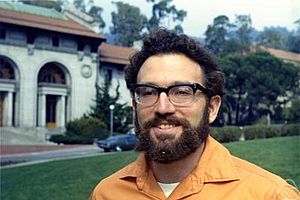Kenneth Kunen facts for kids
Quick facts for kids
Kenneth Kunen
|
|
|---|---|

Kunen, Hearst Mining Building, 1972
|
|
| Born |
Herbert Kenneth Kunen
August 2, 1943 |
| Died | August 14, 2020 (aged 77) |
| Nationality | American |
| Alma mater | California Institute of Technology Stanford University |
| Known for | set theory, set-theoretic topology, non-associative algebraic systems |
| Scientific career | |
| Fields | Mathematics |
| Institutions | University of Wisconsin–Madison |
| Doctoral advisor | Dana Scott |
Herbert Kenneth Kunen (born August 2, 1943 – died August 14, 2020) was an American professor of mathematics. He taught at the University of Wisconsin–Madison. Kunen was known for his work in set theory, which is a branch of mathematics that studies collections of objects. He also applied set theory to other areas like topology (the study of shapes and spaces) and measure theory (the study of size and area).
Kunen also explored non-associative algebraic systems, such as loops. He even used computer programs, like the Otter theorem prover, to help him discover new mathematical ideas in these fields.
Contents
About Kenneth Kunen's Life
Kunen was born in New York City in 1943. He passed away in 2020. For many years, he lived in Madison, Wisconsin, with his wife, Anne. They had two sons named Isaac and Adam.
His Journey in Education
Kenneth Kunen studied at the California Institute of Technology for his first degree. Later, he earned his Ph.D. in 1968 from Stanford University. His main teacher and guide during his Ph.D. studies was a famous mathematician named Dana Scott.
Discoveries and Research in Mathematics
Kunen made important contributions to set theory. He explored very complex ideas about how different mathematical "universes" or models relate to each other. One of his most famous findings is called Kunen's inconsistency theorem. This theorem showed that certain very large mathematical concepts, known as "large cardinals," could not exist in a specific way that some mathematicians had imagined.
He also developed a method called "iterated ultrapowers." This method helped him prove that if certain types of very large numbers (called measurable cardinals) exist, then there are specific mathematical models that also contain many of these large numbers.
Beyond these big ideas, Kunen was also known for creating complex mathematical structures using methods like forcing. He showed that some mathematical rules could fail in surprising ways. For example, he proved that it's possible for a rule called Martin's axiom to stop working at a certain point. He also worked on the properties of sets of numbers, showing that some collections of numbers don't have certain kinds of long, increasing chains. The concept of a Jech–Kunen tree is named after him and another mathematician, Thomas Jech.
Books and Publications
Kenneth Kunen wrote several important books and papers about mathematics. Here are some of his selected works:
- Set Theory. College Publications, 2011. ISBN: 978-1848900509.
- The Foundations of Mathematics. College Publications, 2009. ISBN: 978-1-904987-14-7.
- Set Theory: An Introduction to Independence Proofs. North-Holland, 1980. ISBN: 0-444-85401-0.
- (co-edited with Jerry E. Vaughan). Handbook of Set-Theoretic Topology. North-Holland, 1984. ISBN: 0-444-86580-2.

